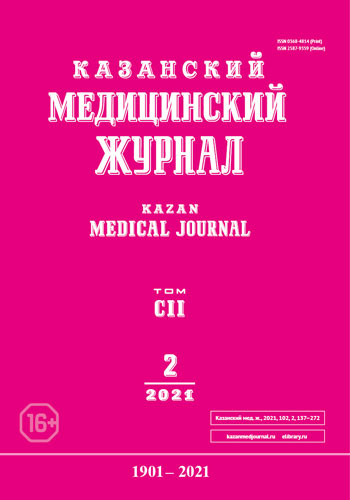Эпидемиологические аспекты центральной серозной хориоретинопатии
- Авторы: Аглиуллин Д.Р.1, Хасанова Г.Р.1, Абдулаева Э.А.2, Аглиуллина С.Т.1, Амиров А.Н.2, Кусков А.Н.3, Ким А.А.4, Расческов А.Ю.5, Липинский Д.А.6
-
Учреждения:
- Казанский государственный медицинский университет
- Казанская государственная медицинская академия — филиал Российской медицинской академии последипломного образования
- Республиканская клиническая офтальмологическая больница им. Е.В. Адамюка
- Клиника «Корд»
- Офтальмологический центр «Глазная хирургия Расчёсков»
- Офтальмологическая клиника «Третий глаз»
- Выпуск: Том 102, № 2 (2021)
- Страницы: 228-233
- Раздел: Социальная гигиена и организация здравоохранения
- Статья получена: 06.01.2021
- Статья одобрена: 18.03.2021
- Статья опубликована: 06.04.2021
- URL: https://kazanmedjournal.ru/kazanmedj/article/view/57597
- DOI: https://doi.org/10.17816/KMJ2021-228
- ID: 57597
Цитировать
Аннотация
Цель. Анализ заболеваемости центральной серозной хориоретинопатией среди населения г. Казани за период 2009–2018 гг.
Методы. Проведено описательное эпидемиологическое исследование заболеваемости центральной серозной хориоретинопатией населения г. Казани за 2009–2018 гг., включая анализ многолетней динамики заболеваемости мужского и женского населения и оценку структуры заболеваемости по полу суммарно за период и в динамике. Сравнительный анализ данных проведён с использованием непараметрических критериев Манна–Уитни и χ2 (с поправкой Йейтса).
Результаты. За 2009–2018 гг. был зарегистрирован 831 новый случай центральной серозной хориоретинопатии в г. Казани, соотношение мужчин и женщин составило 1:1. В динамике отмечены рост доли мужчин с 24,2% в 2009 г. до 60,7% в 2018 г. (р=0,000002) и снижение доли женщин с 75,8% в 2009 г. до 39,3% в 2018 г. (р=0,000002). Для многолетней динамики за 2009−2018 гг. характерен статистически значимый рост инцидентности центральной серозной хориоретинопатии среди мужчин (р=0,004) с 3,2 на 100 тыс. в 2009 г. до 14,8 на 100 тыс. в 2018 г. За изучаемый период заболеваемость женщин сохраняется на одном уровне, варьируя от 5,4 до 8 на 100 тыс. (p=0,663). Мужчины чаще заболевают центральной серозной хориоретинопатией в более молодом возрасте (р=0,0001). У женщин медиана возраста на момент диагностики заболевания составила 55 лет (Q25–Q75 45–65 лет), у мужчин — 45 лет (Q25–Q75 37–56 лет).
Вывод. За 2009–2018 гг. в Казани заболеваемость мужчин центральной серозной хориоретинопатией значимо возросла как в интенсивных (р=0,004), так и в экстенсивных показателях (р=0,000002); центральная серозная хориоретинопатия у мужчин развивается в более раннем возрасте, чем у женщин (Ме возраста женщин на момент постановки диагноза 55 лет, мужчин — 45 лет; р=0,0001).
Полный текст
Об авторах
Дамир Ришатович Аглиуллин
Казанский государственный медицинский университет
Автор, ответственный за переписку.
Email: dr.agliullin@gmail.com
ORCID iD: 0000-0001-7474-609X
SPIN-код: 1356-0270
Россия, г. Казань, Россия
Гульшат Рашатовна Хасанова
Казанский государственный медицинский университет
Email: gulshatra@mail.ru
ORCID iD: 0000-0002-1733-2576
SPIN-код: 6704-2840
Россия, г. Казань, Россия
Эльмира Абдулаевна Абдулаева
Казанская государственная медицинская академия — филиал Российской медицинской академии последипломного образования
Email: abd@inbox.ru
ORCID iD: 0000-0003-3538-9354
SPIN-код: 9611-1344
Россия, г. Казань, Россия
Саида Тахировна Аглиуллина
Казанский государственный медицинский университет
Email: saida.agliullina@kazangmu.ru
ORCID iD: 0000-0003-4733-6911
SPIN-код: 2079-1833
Россия, г. Казань, Россия
Айдар Наилевич Амиров
Казанская государственная медицинская академия — филиал Российской медицинской академии последипломного образования
Email: ksma.rf@tatar.ru
SPIN-код: 7833-9650
Россия, г. Казань, Россия
Александр Николаевич Кусков
Республиканская клиническая офтальмологическая больница им. Е.В. Адамюка
Email: zorg3128@gmail.com
Россия, г. Казань, Россия
Алексей Альбертович Ким
Клиника «Корд»
Email: kim.alexey87@gmail.com
Россия, г. Казань, Россия
Александр Юрьевич Расческов
Офтальмологический центр «Глазная хирургия Расчёсков»
Email: raskovclinic@mail.ru
Россия, г. Казань, Россия
Дмитрий Андреевич Липинский
Офтальмологическая клиника «Третий глаз»
Email: 3eyes-clinic@mail.ru
Россия, г. Казань, Россия
Список литературы
- Gemenetzi M., De Salvo G., Lotery A.J. Central serous chorioretinopathy: an update on pathogenesis and treatment. Eye (Lond.). 2010; 24 (12): 1743–1756. doi: 10.1038/eye.2010.130.
- Wang M., Munch I.C., Hasler P.W., Prunte C., Larsen M. Central serous chorioretinopathy. Acta Ophthalmol. 2008; 86 (2): 126–145. doi: 10.1111/j.1600-0420.2007.00889.x.
- Хасанова Г.Р., Хакимов Н.М., Аглиуллин Д.Р., Абдулаева Э.А. Факторы риска развития центральной серозной хориоретинопатии. Систематический обзор и метаанализ. Медицина. 2020; 8 (1): 102–124. doi: 10.29234/2308-9113-2020-8-1-102-124.
- Liew G., Quin G., Gillies M., Fraser-Bell S. Central serous chorioretinopathy: a review of epidemiology and pathophysiology. Clin. Experim. Ophthalmol. 2013; 41: 201–214. doi: 10.1111/j.1442-9071.2012.02848.x.
- Kitzmann A.S., Pulido J.S., Diehl N.N., Hodge D.O., Burke J.P. The incidence of central serous chorioretinopathy in Olmsted County, Minnesota, 1980–2002. Ophthalmology. 2008; 115: 169–173. doi: 10.1016/j.ophtha.2007.02.032.
- Tsai D.C., Chen S.J., Huang C.C. Epidemiology of idiopathic central serous chorioretinopathy in Taiwan, 2001–2006: a population-based study. PLoS One. 2013; 8 (6): е66858. doi: 10.1371/journal.pone.0066858.
- Савилов Е.Д., Астафьев В.А., Жданова С.Н., Заруднев Е.А. Эпидемиологический анализ: методы статистической обработки материала. Новосибирск: Наука-Центр. 2011; 156 с.
- Yildiz O., Seyrek M. Vasodilating mechanisms of testosterone. Exp. Clin. Endocrinol. Diabetes. 2007; 115 (1): 1–6. doi: 10.1055/s-2007-949657.
- Ahad M.A., Chua C.N., Evans N.M. Central serous chorioretinopathy associated with testosterone therapy. Eye. 2005; 20: 503–505. doi: 10.1038/sj.eye.6701905.
- Ciloglu E., Unal F., Dogan N.C. The relationship between the central serous chorioretinopathy, choroidal thickness, and serum hormone levels. Graefes Arch. Clin. Exp. Ophthalmol. 2018; 256 (6): 1111–1116. doi: 10.1007/s00417-018-3985-x.
- Haimovici R., Koh S., Gagnon D.R., Lehrfeld T., Wellik S. Risk factors for central serous chorioretinopathy: a case-control study. Ophthalmology. 2004; 111: 244–249. doi: 10.1016/j.ophtha.2003.09.024.
- Chumbley L.C., Frank R.N. Central serous retinopathy and pregnancy. Am. J. Ophthalmol. 1974; 77 (2): 158–160. doi: 10.1016/0002-9394(74)90667-9.
- Morikawa M., Cho K., Kojima T., Chiba K., Ishikawa S., Umazume T., Nakagawa K., Yamada T., Yamada T., Minakami H. Risk factors for central serous chorioretinopathy in pregnant Japanese women. J. Obstet. Gynaecol. Res. 2017; 43 (5): 866–872. doi: 10.1111/jog.13289.
- Ersoz M.G., Arf S., Hocaoglu M., Sayman Muslubas I., Karacorlu M. Patient characteristics and risk factors for central serous chorioretinopathy: an analysis of 811 patients. Brit. J. Ophthalmol. 2019; 103 (6): 725–729. doi: 10.1136/bjophthalmol-2018-312431.
- Chatziralli I., Kabanarou S.A., Parikakis E., Chatzirallis A., Xirou T., Mitropoulos P. Risk factors for central serous chorioretinopathy: multivariate approach in a case-control study. Curr. Eye Res. 2017; 42 (7): 1069–1073. doi: 10.1080/02713683.2016.1276196.
- Conway M.D., Noble J.A., Peyman G.A. Central serous chorioretinopathy in postmenopausal women receiving exogenous testosterone. Retin. Cases Brief. Rep. 2017; 11 (2): 95–99. doi: 10.1097/ICB.0000000000000298.
- Аглиуллин Д.Р., Хасанова Г.Р., Абдулаева Э.А., Аглиуллина С.Т., Амиров А.Н., Кусков А.Н., Ким А.А., Расчёсков А.Ю., Липинский Д.А. Заболеваемость центральной серозной хориоретинопатией населения г. Казани: результаты ретроспективного эпидемиологического анализа за 2009–2018 гг. Тихоокеанский мед. ж. 2020; (3): 30–33. doi: 10.34215/1609-1175-2020-3-30-33.
Дополнительные файлы










